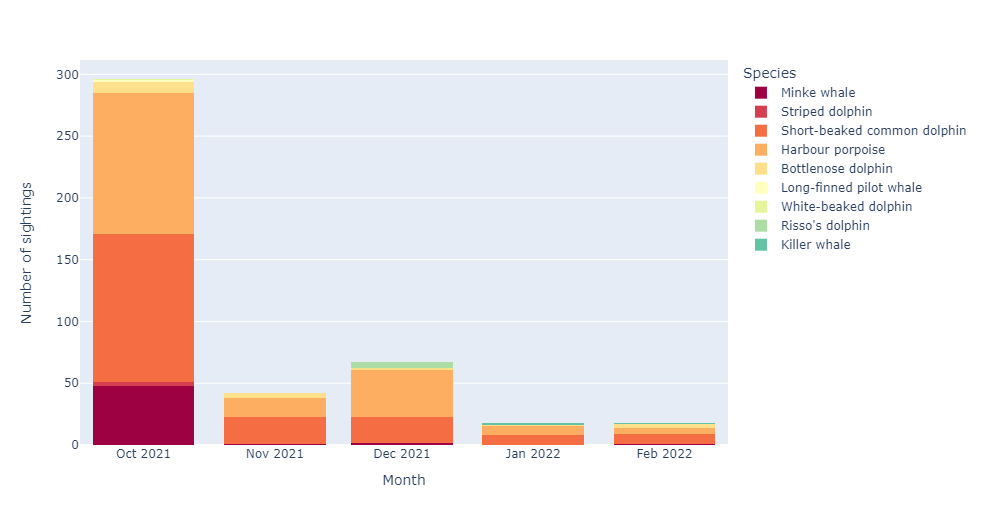Whale Track Winter Sightings Round-Up
The porpoise is our smallest cetacean in Scotland, resident year-round and reported regularly over winter
Sighting reports of cetaceans – the collective term for whales, dolphins and porpoises - usually slow down over the winter months in the Hebrides. Colder weather, limited daylight and less people out on the water can influence the number of reports submitted by our Whale Track community. But, it’s a crucial time to gather data so we have a year-round record of cetacean distribution and abundance off Scotland’s west coast. We want to thank our fantastic team of Whale Track reporters who have sent in sighting reports this winter – you are improving our understanding of the Hebridean marine environment.
WHAT HAVE OUR WHALE TRACK COMMUNITY SPOTTED?
A total of 469 sightings from 90 reporters were sent in between the start of October 2021 and end of February 2022. Over half of these were from effort-based boat excursions, a quarter from casual sightings at sea and quarter from casual sightings from land. A total of 3,170 animals from 9 different species were recorded, with common dolphins being the most abundant species in every month – with over 2,000 individuals in total reported - and harbour porpoise coming in second - with a count of almost 600 individuals spotted.
Graph showing the different species and the number reported through Whale Track during the winter months
COMMON DOLPHINS
Historically, common dolphins were summer visitors to the Hebrides, with October generally being the last month they were seen before migrating and heading south to warmer waters for the winter. However, in the last 15 years, there have been many anecdotal reports of common dolphins being seen in winter months, and travelling further north than their usual range. Thanks to our Whale Track community, combined with data collected from on board our research vessel, Silurian, we are documenting the changes that are taking place within this population. By collecting data over a long period of time, we can track the changes in trends, such as distribution, range and migration patterns.
Changes in common dolphin sightings rate over time are being documented in the Hebrides
BOTTLENOSE DOLHINS
One of our resident species, bottlenose dolphins, were seen throughout winter. Cally Sutherland, while watching form land, had a fantastic sighting of a pod of bottlenose dolphins. And Fergus Reade snapped this great shot while out with Turus Mara, south of Easdale. Photographs are vital in allowing us to identify individuals and distinguish between populations. Thanks to Photo Identification, we know there are two distinct populations of bottlenose dolphins on the west coast; a small population of approx. 15 around Barra, known as the Barra Boys (although they are not all boys!) and a larger population of approx. 30 - 40 seen around the Inner Hebrides. If you have any photographs of dorsal fins of bottlenose dolphin, minke whale, Risso’s dolphin or killer whale, please send them to sightings@hwdt.org with details of where and when you saw them.
MINKE WHALES
Gorden Bruce, from Staffa Trips, had an amazing encounter with possibly as many as five minke whales in October - one with a distinct nick in its dorsal fin. Minke whales generally leave Scottish waters in October, returning in early summer, however the last reported minke in 2021 was seen in December, with a couple of reports of minkes spotted between Ullapool and Stornoway and Uig and Tarbet. This year we’ve already received a report of a minke whale - with an indivdual spotted off Tiree in February.
The minke whale spotted by Gordon Bruce of Staffa Trips, with a very distinctive nick in the dorsal fin
RISSO’S DOLPHINS
December was a good month for Risso’s sightings, with 17 reported on five separate occasions. Jan Storie had a couple of encounters with a mother/calf pair during a ferry trip to Stornoway. Risso’s dolphin calves are born grey but turn brown as they become juveniles. The older they get, their skin lightens to a silvery grey and becomes covered in scars, usually caused by other Risso’s dolphins and their prey species, squid.
KILLER WHALES
John-Archie-Campbell had a good start to the year with a sighting of killer whales in both January and February, including a breaching orca close to the ferry approaching Lochmaddy entrance. His luck continued in February, where he saw two killer whales again close to Lochmaddy, possibly John Coe and Aquarius.
In addition to the sightings through Whale Track, five sightings came in through social media. John Coe and Aquarius were confirmed by photo ID as being seen from Neist Point, Skye, by Sarah Sia in November, then again at Lochmaddy a couple weeks after John-Archie-Campbell’s sighting.
John Coe, spotted by Sarah Sia from Neist Point on Skye in November 2021
You can explore all these encounters and more through our interactive map, generated by all the sightings reported by our Whale Track community. Through this map, you can filter for species and date range – you can also zoom in on specific areas to discover what’s been spotted there.
As we move into spring and the weather improves and the evenings get longer, we are excited about what sightings will be recorded through Whale Track. We are also getting excited about releasing the upgraded version of our Whale Track app which is coming soon, so watch this space!
Huge thanks to the Coop Community Fund and the Q Charitable Trust for funding Whale Track









